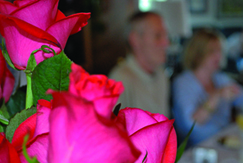Flowers speak louder than words
Valentine's Day staples convey meaning in a special way
Whether it's a dozen red roses, a single carnation or a flowering potted plant, the emotional power of giving flowers on Valentine's Day remains strong, according to Richard Mattson, a K-State professor of horticulture.
 Mattson, who also is coordinator of K-State's undergraduate horticultural therapy program, said it is no wonder that the Society of American Florists has the slogan "Say it with Flowers," as flowers really do have the power to convey feelings without using words. He said that flowers have a very strong psychological impact connected to their fragrance and color.
Mattson, who also is coordinator of K-State's undergraduate horticultural therapy program, said it is no wonder that the Society of American Florists has the slogan "Say it with Flowers," as flowers really do have the power to convey feelings without using words. He said that flowers have a very strong psychological impact connected to their fragrance and color.
Mattson and one of his doctorate students, Seong-Hyun Park, recently published research on the impact of flowers and plants present in the recovery rooms of appendectomy patients. They found that the patients who were recovering in rooms filled with plants and flowers had more positive physiological responses, such as lower blood pressure, lower heart rate, and less pain, anxiety and fatigue. They also required less pain medication than the patients in rooms without flowers and plants.
"Flowers are a universal material — everybody understands their meaning," Mattson said. "Flowers are sensory stimulating and reduce stress. They can have a very powerful impact on a person."
For many decades, the traditional Valentine's Day flower has been the red rose. Mattson said that red roses are romantic because their color represents a deep powerful emotion and conveys the concept of love. He also said red roses make people feel good about themselves because they are reassured that somebody loves them.
"There is something sensory stimulating about a rose as well as its visual attractiveness," Mattson said. "It also is important to remember that a single red rose can be just as pleasing as a dozen. It is the thought that is important because you are saying something with flowers. It doesn't have to be expensive."
The type of flower one gives on Valentine's Day depends on the message they want to convey as well as the person's stage of life, Mattson said. For example, when giving flowers to an elderly person, you might consider a combination of white or yellow daisies, carnations and chrysanthemums. Mattson said arrangements of white and lighter colors may symbolize respect if given to an elderly person and are also more visual to aging eyes.
"The human eye is most sensitive to the color yellow, whereas reds and violets tend to blend into green foliage backgrounds," Mattson said. "White flowers also have been traditionally used in wedding bouquets to symbolize purity and innocence."
When giving flowers based on friendship, use a mixture of colors. Mattson suggests flowering potted plants for this type of relationship.
"There are a lot of beautiful winter potted plants, such as cyclamen, begonias or kalanchoes," he said. "Flowering plants make very nice long-lasting gifts because cut flowers eventually die and get thrown away."
To increase the vase life of cut flowers, Mattson suggests putting a copper penny in the vase, which will help prevent microbial growth, and a tiny amount of sugar in the water, which works like food to sustain the cut flower. He also said that the bottom of rose flower stems should be cut off daily to increase water uptake and to prevent wilting.